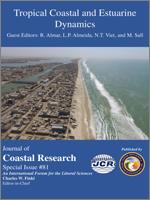Tropical coasts are currently facing an intensification of coastal risks under increasing demographic pressure, natural hazard and uncontrolled exploitation of resources associated with rapid economic development. All these issues draw attention to the need of a greater understanding of present dynamic and future evolution of these environments. The functioning of these tropical sandy environments (e.g., under extreme events, monsoons, storm-free low-energy, large steric sea level variations, climatic modes) is, in general, scarcely documented in scientific literature. Tropical coasts cover a large part of world coastal environments. While the sediment composition and the geomorphology of these environments resemble the extensively studied mid/high latitude coasts, the oceanic forcing is fundamentally distinct. Such aspect limitates the direct application of existing knowledge on sandy environments and recalls for the need of observations and studies on these environments.
The foundations of this Special Issue are linked to the outputs of the COASTVAR project (Coastal Variability of Vietnam and West Africa) together with several other contributions from various regions and environments (e.g., natural and anthropized, coastal and estuarine areas). This project aims at understanding the processes responsible for the observed large coastal variability and quantifying their impact. This project is an important step to not only improving our understanding of coastal dynamics in vulnerable and non-documented tropical environments, but more generally providing fundamental insight in the functioning of coastal zones: (1) bridging the knowledge gap in event-scale beach evolution and more specifically on hydro-sedimentary mechanisms linking the upper beachand surf-zone dynamics. This includes the study of extreme events and crucial but mostly unknown beach recovery; (2) identifying the hydrodynamic processes involved in cross-shore exchanges between nearshore and shelf zones and the role of transient currents; (3) understanding the sources of coastal variability at various scales, in particular the link between short-term (event scale) and long-term evolution. This includes determining the long-term impact of individual events (and resilience ?) and the coastal response to oceanic forcing with seasonal modulation of wave conditions or regional climatic modes.
A diversity of oceanic forcing was addressed in this Special Issue, ranging from storm-free coasts exposed to extra-tropical long swells (e.g., West Africa), coasts exposed to extreme tropical storms such as hurricanes or typhoons (e.g., Caribbean and South East Asia) and coasts exposed to steady trade winds (e.g., Brazil). The short-term morphological response and long-term evolution of these coastal areas is closely linked to the ocean forcing variability, such as the significant inter annual component (climatic modes such as ENSO) and extremes. To forecast the evolution of Tropical coastal zone requires to address the following challenges: (1) identify the dominant hydrodynamic processes that drive morphological changes, link the spatio-temporal scales and downscale from regional to local scale; (2) reinforce multidisciplinary studies that link socio-economic and environmental aspects and develop suited observation and modelling tools as a support to coastal management decisions. The studies developed in this Special Issue document tropical coastal systems by acquiring unparalleled data set through reliable and innovative observation techniques (e.g., satellite, video, drone, conventional in situ observations) and the application of recent modelling approaches (three-dimensional coastal models, shoreline and beach evolution predictor).
In this issue, Vietnam receives great attention with 5 papers. The approaches involved is generally based on a strong link between fundamental research and engineering practices, and the morphology is described at seasonal scale in Thanh et al. (2018) at Nha Trang Bay, completed with solutions for complexity simplified models of wave propagation to the coast in Hai Ly et al. (2018) and morphodynamics evolution of sandpit in Duy et al. (2018) and rivermouth in Chien et al. (2018). Beach nourishment strategy efficiency is studied in Thuy et al. (2018).
The Caribe and Atlantic Brazilian coasts are represented by 4 papers. A case study in Brazil on reef substract zonation and its relationship with reef geometry and sediment composition in Correia et al. (2018). Colombian soft-cliff erosion is investigated in Paniagua-Arroyave et al. (2018) and linked with Caribe oceanic forcing. Wozencraft et al. (2018) develop a strategy to support coastal zone management based on spatial indexes while Kobashi et al. (2018) investigate the impact of sand mining on hydrodynamics.
West and Central African coasts are represented by 8 papers. Thoreux et al. (2018) extract the sea level from satellite along Senegalese coast, while Ngom et al. (2018) monitor the evolution of a densely populated coast exposed to large erosion. In the Gulf of Guinea, hydrodynamics of unsteady flash rip currents in Benin attracted the attention of Scott et al. (2018) and Floc'h et al. (2018a) while Floc'h et al. (2018b) investigate the role of these events on sediment transport and Bonou et al. (2018) quantify the 2D and 3D variability of shoreline dynamics. Houngue et al. (2018) quantify the statistics of wave climate off the coast. In a satellite study, Abessolo Ondoa et al. (2018) determine the evolution of an estuary in Cameroon from satellite imagery.
The research presented in this Journal of Coastal Research (JCR) Special Issue provides a contribution to a better understanding of tropical coastal environments. Unique quality datasets are presented to the community in these scarcely documented environments. Major advances have been made in the methodological aspects of the development of field and remote sensing methods. These observations have been used to test various numerical models which now offer a major capacity for studying hydro-sedimentary processes. In addition to the scientific findings, this Special Issue highlights the need to improve the spatio-temporal coverage of observations and the need for hydro-sedimentary modelling to improve the prediction of coastal state evolution in these challenging environments. This Special Issue builds toward improving local policies by providing guidelines and anticipating evolution under climatic changes and anthropization.
Rafael Almar
IRD-LEGOS
Toulouse, France
Luis Pedro Almeida
Universidade Federal do Rio
Grande, Rio Grande, Brazil
Nguyen Trung Viet
Thuy Loi University
Hanoi, Vietnam
Moussa Sall
CSE-MOLOA
Dakar, Senegal













